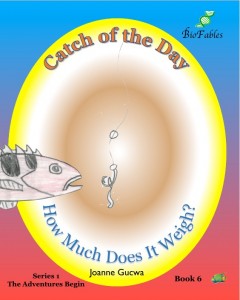
An end-of-summer weekend at a friend’s “swimming hole” in the middle of farmland doesn’t sound particularly exciting. Except for a mysterious splashing in the night, that is.
Swimming doesn’t bring to mind exciting lessons in physics, either. Except when you factor into the equation a water trampoline and a dog.
What secret does an eleven-pound largemouth bass reveal as it’s cleaned for grilling? For that matter, what fun surprises await in the family garden when they return home?
BioFables children’s books focus on illuminating Sciences (STEM: Science, Technology, Engineering, Math) principles through fun stories. Parents, you know from experience that learning the subject matter that we call Sciences is a good first step. Understanding Humanities subjects helps us know how best to apply Sciences principles to the practical needs of the external world. And understanding one’s internal Values/Behaviors helps us to make things happen.
Every BioFables book weaves lessons derived from these interconnected (and often hidden) core disciplines into realistic stories that children relate to. Parents, you can use the free resources of this site to uncover those nearly-invisible lessons. They will help you prepare your children for happy, productive, rewarding and well-balanced lives.
If you’re ready to purchase Catch of the Day, please click on the Buy Catch of the Day icon to go directly to Barnes and Nobles’ Catch of the Day page. (Your purchase of Catch of the Day helps support our ongoing efforts to continue expanding the wealth of this site’s free resources for homeschooling and all parents who are dedicated to the intellectual growth of their children)
If you’d like to learn more about using the considerable Catch of the Day resources at this site, please read on.
Catch of the Day Resources
The ten chapters in Catch of the Day contain nearly a hundred practical mini-lessons and pop-up lessons woven throughout Catch of the Day. We call these practical lessons Knowledge Nuggets. These Knowledge Nuggets contain specific information that readers can apply to their everyday lives. They may be in the form of a mini-lesson, with simple explanations of a specific concept, or as a quick, unplanned pop-up lesson.
Four sets of tables and lists in the Catch of the Day Knowledge Gateways page help you to place a given Knowledge Nugget within the greater realm of learning.
-
- Chapter-by-Chapter: Sciences, Humanities, Values/Behaviors
- Entire Catch of the Day: Sciences topics
- Entire Catch of the Day: Humanities topics
- Entire Catch of the Day: Values/Behaviors topics
Please visit SITE TIPS for even more ways to mine the wealth of information available on this site.

